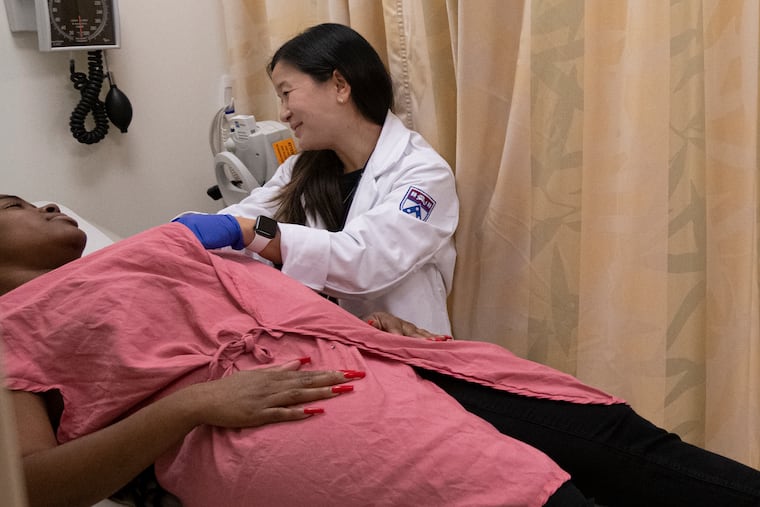Doctors disagree on whether breast self-exams for women with average cancer risk are helpful or harmful
Research found that women with average risk who did self-exams were more likely to be put through unnecessary tests, scans, and biopsies and were no less likely to develop or die from cancer.

Nicole Crosby carefully presses on her breast tissue, scanning with her fingers for unusual lumps.
She doesn’t have a family history of breast cancer, and at 37 years old, is still a few years from when medical guidelines recommend women begin receiving mammograms. Crosby sees her doctor annually for a checkup and clinical breast exam, but feels better checking herself once a month, rather than waiting.
“I think it’s important,” said Crosby, who lives in Haddonfield, N.J. “If you found something, you’d want to catch it early.”
But she was surprised to learn that the American Cancer Society hasn’t recommended breast self-exams or clinical exams in the doctor’s office since 2015.
The American Cancer Society updated its earlier guidance for self-exams after research found that most women were more likely to be put through unnecessary tests and scans and have biopsies — yet were no less likely to develop or die of breast cancer. Current guidelines from the American Cancer Society and the American College of Obstetricians and Gynecologists, which sets care guidelines for physicians, instead focus on mammograms, which are far more reliable in detecting cancer. ACOG recommends people of average risk begin annual or biennial mammograms no later than age 50.
Still, doctors disagree on whether self-exams should play a supporting role in early detection. While some argue that self-exams offer extra protection, other doctors say they can do more harm than good and even lead patients to skip vital mammograms, ultrasounds, and advanced 3D imaging. These tests and scans are the undisputed gold standard for identifying cancer.
“Self-exams produce more anxiety because there’s a higher chance that patients will find something they think is abnormal but is actually benign or not worrisome,” said Victoria Mui, assistant professor of clinical obstetrics and gynecology at the Perlman School of Medicine. “Patients feel more relieved to know that a clinician is performing an exam.”
Mui doesn’t recommend self-exams to her patients who have an average risk of breast cancer, though she always offers clinical exams during appointments.
Pros and cons of self-exams
Someone with very dense breasts, for example, may feel lumps and bumps that are part of the normal architecture of their breasts, but be anxious that they have cancer, said Arif Kamal, chief patient officer of the ACS, based in Chapel Hill, N.C.
Kamal recommends patients talk to their doctor about whether self-exams are right for them. A doctor can help understand what to look for and what time of month to check. Everyone’s breast tissue is different, and where you are in your menstrual cycle can change the texture of your breast tissue.
“Know what normal is for you,” Kamal said.
Angela Jain, assistant professor in the Department of Hematology and Oncology at Fox Chase Cancer Center, has a different take. She views self-exams as an extra layer of protection.
“To do more is not wrong,” she said. “Even if women do a self-exam every couple of months, they’ll know if something feels different. It’s that change we’re looking for.”
Jain recommends patients call their doctor if they have any new pain, swelling, discharge, changes in their skin, or notice a lump or bump the size of a pea. Don’t dismiss tiny bumps that don’t hurt — painless bumps are more likely to be cancerous, she said.
While Leslie Saltzman, medical director at the Rittenhouse Women’s Wellness Center, doesn’t believe clinical exams are necessary, she does them as a way to start the conversation with her patients around making sure they are getting appropriate screening. They discuss risk factors and family history to provide the right recommendations for each individual.
Don’t skip the mammogram
Clinical and self-exams may be particularly useful for people with a family history of cancer, but there’s no substitute for mammograms, which is how most breast cancers are found, Mui said. Annual high-quality mammograms are offered at breast clinics, hospital radiology departments, mobile vans, private radiology offices, and many doctors’ offices. Some are open seven days a week with evening hours.
The Penn Medicine Breast Health Initiative offers free mammograms for women who are uninsured or underinsured and also includes any tests or biopsies that must be done as a follow-up, said Mui.
Breast cancer is typically slow growing, Kamal said. So don’t panic if you are one of the six million women who has missed your annual screenings for breast and cervical cancer during the pandemic. Schedule your mammogram now.
“Self-exams are clearly more amenable, potentially less painful, and more convenient than a mammogram,” Kamal said. “But you have to get a mammogram no matter what.”